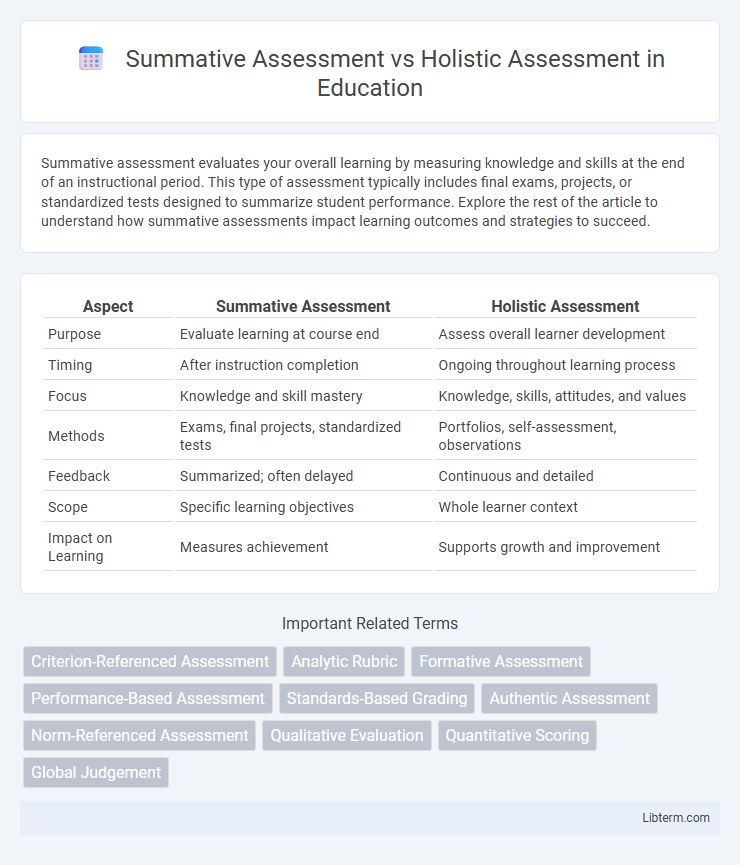Summative assessment evaluates your overall learning by measuring knowledge and skills at the end of an instructional period. This type of assessment typically includes final exams, projects, or standardized tests designed to summarize student performance. Explore the rest of the article to understand how summative assessments impact learning outcomes and strategies to succeed.
Table of Comparison
| Aspect | Summative Assessment | Holistic Assessment |
|---|---|---|
| Purpose | Evaluate learning at course end | Assess overall learner development |
| Timing | After instruction completion | Ongoing throughout learning process |
| Focus | Knowledge and skill mastery | Knowledge, skills, attitudes, and values |
| Methods | Exams, final projects, standardized tests | Portfolios, self-assessment, observations |
| Feedback | Summarized; often delayed | Continuous and detailed |
| Scope | Specific learning objectives | Whole learner context |
| Impact on Learning | Measures achievement | Supports growth and improvement |
Understanding Summative Assessment
Summative assessment evaluates student learning at the end of an instructional period by measuring achievement against predefined standards or objectives. It typically takes the form of exams, final projects, or standardized tests designed to quantify knowledge and skills acquired. This data-driven approach provides clear metrics for grading and accountability but may not capture the full depth of student understanding or learning process.
Defining Holistic Assessment
Holistic assessment evaluates a learner's overall performance by integrating multiple competencies, skills, and knowledge areas into a single, comprehensive judgment. Unlike summative assessment, which measures specific learning outcomes at the end of an instructional period, holistic assessment emphasizes context, process, and the interconnectedness of learning experiences. This approach supports a more nuanced understanding of student development and encourages reflection on both strengths and areas for growth.
Key Differences Between Summative and Holistic Assessment
Summative assessment evaluates student learning by measuring knowledge and skills at the end of an instructional period, typically through standardized tests or final exams with quantitative scores. Holistic assessment considers the overall development of a learner by integrating multiple criteria, such as creativity, critical thinking, and social skills, using qualitative methods like portfolios, presentations, and self-reflection. Key differences include summative assessment's focus on final outcomes and specific competencies, whereas holistic assessment emphasizes continuous growth and the broader context of learning experiences.
Objectives of Summative Assessment
Summative assessment aims to evaluate student learning by measuring achievement against predefined standards or objectives at the end of an instructional period. It focuses on quantifying knowledge, skills, and competencies through exams, final projects, or standardized tests. The primary objective is to determine overall academic performance and inform decisions on student progression or certification.
Goals of Holistic Assessment
Holistic assessment aims to evaluate a learner's overall development by integrating cognitive, emotional, social, and practical skills into a single comprehensive evaluation. Its goal is to provide a more accurate reflection of real-world performance and personal growth, rather than isolated academic achievements measured by summative assessment. This approach fosters deeper understanding, critical thinking, and lifelong learning by considering multiple dimensions of student competence and progress.
Advantages of Summative Assessment
Summative assessment provides clear, objective measurements of student learning outcomes through standardized tests or final exams, facilitating efficient evaluation of knowledge comprehension. It offers valuable data for benchmarking, curriculum effectiveness, and accountability by quantifying achievement at specific points in time. Schools and educators benefit from summative assessment's structured format, enabling straightforward grading and comparison across diverse student populations.
Benefits of Holistic Assessment
Holistic assessment offers a comprehensive evaluation by considering multiple dimensions of learner performance, including critical thinking, creativity, and collaboration skills, which are often overlooked in summative assessments. It promotes a deeper understanding of student progress by integrating formative feedback and real-world application, enhancing personalized learning experiences. By supporting continuous growth and self-reflection, holistic assessment fosters motivation and long-term academic success beyond standardized test results.
Challenges of Both Assessment Types
Summative assessment faces challenges such as limited feedback opportunities and potential bias due to its high-stakes nature, which can impact student motivation and accurately measuring learning outcomes. Holistic assessment struggles with subjectivity and inconsistency in scoring, making it difficult to ensure reliability and fairness across different evaluators. Both types require careful design and implementation to balance comprehensive evaluation with standardized measurement.
When to Use Summative vs Holistic Assessment
Summative assessment is best used at the end of a learning period to measure overall student achievement against specific standards or benchmarks, providing quantifiable data for grading and accountability. Holistic assessment is ideal during ongoing learning processes to evaluate students' overall development, creativity, and critical thinking through qualitative judgment rather than isolated skills. Choosing between summative and holistic assessment depends on the goal: summative for evaluating final mastery, holistic for fostering and understanding complex learning outcomes.
Impact on Student Learning and Development
Summative assessment provides a clear measurement of student learning outcomes, enabling educators to identify proficiency levels and curriculum gaps. Holistic assessment evaluates cognitive, emotional, and social development, fostering comprehensive growth and critical thinking skills. Combining both approaches enhances personalized feedback, promoting deeper learning and sustained student development.
Summative Assessment Infographic

 libterm.com
libterm.com